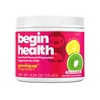Simple Meal Prep Tips for Boosting Your Kid's Magnesium Intake
share this article

Magnesium is a key mineral that supports your little one’s electrolyte balance, muscle function, and bone development (1). But it can be tough for kids to get enough because magnesium is mostly found in foods like leafy greens, beans, and seeds, which aren't always kid-friendly foods.
When magnesium levels are too low, it can lead to poor appetite, fatigue, nausea, muscle cramps, tingling, or even irregular heart rhythms (2).
To avoid these symptoms and help your kiddo get all the magnesium they need, let’s cover kid-friendly magnesium-rich foods and some meal prep tips for boosting their intake.
How Much Magnesium Do Kids Need?
Although you don’t need to be tracking your kiddo’s magnesium intake, reference ranges can be helpful to identify if your little one is close to the necessary range.
Daily magnesium intake varies by age (2):
-
0-6 months: 30mg
-
7-12 months: 75mg
-
1-3 years: 80mg
-
4-8 years: 130mg
-
9-13 years: 240mg
-
14-18 years (male): 410mg
-
14-18 years (female): 360mg
Kid-Friendly Magnesium Foods
Magnesium content varies in each food, but is generally found in green vegetables, fruits beans, seeds, and nuts. Since every child has their own food preferences, choose magnesium-rich foods your child already likes or pair new options with their favorite foods.
-
Spinach | 157mg per 1 cup cooked
-
Pumpkin Seeds | 156mg per 1 oz
-
Quinoa | 118mg per 1 cup cooked
-
Chia Seeds | 111mg per 1 oz
-
Brown Rice | 86mg per 1 cup cooked
-
Almonds | 77mg per 1 oz
-
Cashews | 74mg per 1 oz
-
Peanuts | 63mg per ¼ cup
-
Black Beans | 60mg per ½ cup
-
Avocado | 58mg per avocado
-
Peanut Butter | 50mg per 2 tablespoons
-
Plain Yogurt | 42mg per 8 oz
-
Banana | 32mg per banana
Magnesium Meal Prep Tips
Along with choosing magnesium-rich foods, there are simple ways to boost magnesium through meal prep.
As always, try to involve your little one in the kitchen and offer a variety of foods when you can. This encourages them to explore new foods, even ones they may have rejected in the past.
Baked Goods Packed with Greens
Cooked spinach is one of the highest sources of magnesium, but can be hard for kids to enjoy. Try incorporating spinach into baked goods for a picky-eater approved option!
Most spinach-based recipes include blending the spinach into a batter like these banana spinach pancakes or even masking the green color with cocoa in these chocolate muffins. These baked goods are a great way to meal prep your kiddo’s healthy treats ahead of time.
Use Seeds as “Sprinkles”
Chia seeds and pumpkin seeds act as a great “toppers” to any sweet or savory foods. Keep them on hand to last-minute sprinkle onto a yogurt bowl, cereal, pasta, soup, sandwich, or wrap.
Homemade Trail Mix
Trail mix combines so many different magnesium sources in one: pumpkin seeds, chia seeds, almonds, cashews, peanuts, banana chips, etc.
Pair these magnesium boosters with some dried fruit and you’ve got a DIY trail mix that’s meal prepped for grab-and-go snacks throughout the week.
Switch Up the Nut Butters
Peanut butter is a source of magnesium, but some of the other nuts like cashews and almonds have a slightly higher magnesium content. Next time you’re meal prepping lunch sandwiches or baked goods that call for peanut butter, try alternating the nut butters used for an easy magnesium boost.
Prep Magnesium-Rich Grains
Cooking a big batch of grains is one of the easiest meal prep tips because it speeds up dinner prep and lasts for days in the fridge. Ahead of the week, batch prep some brown rice, quinoa, or black beans for a magnesium-boosted carbohydrate option.
Summary
For a magnesium boosted week of meals to help with muscle function, strong bones, and electrolyte balance, aim for incorporating greens, beans, and seeds into your kid’s meals. Aim for frequent servings and a variety of foods to make sure your kiddo is getting enough.
















